55 Years Ago: Gemini XII Closes Out a Successful Program, Paves the Way for Apollo
The primary objectives of Project Gemini included proving the techniques required for the Apollo program to fulfill President John F. Kennedy’s goal of landing a man on the Moon and returning him safely to Earth before the end of the 1960s. These techniques included rendezvous and docking, spacewalking, and ensuring that spacecraft and astronauts could function for at least eight days — the minimum time for a roundtrip lunar mission. The nine previous Gemini missions in 1965 and 1966 demonstrated the spacecraft’s space worthiness, the basic feasibility of spacewalking, extended flight durations to 14 days, and space rendezvous and docking techniques. The principal tasks for astronauts James A. Lovell and Edwin E. “Buzz” Aldrin during their four-day Gemini XII mission, the final flight of the program, included docking with a target vehicle, performing three spacewalks, and conducting a tethered spacecraft experiment. To overcome significant issues during several previous spacewalks, astronauts and mission managers placed great emphasis on the use of neutral buoyancy as a high-fidelity tool for spacewalk training.
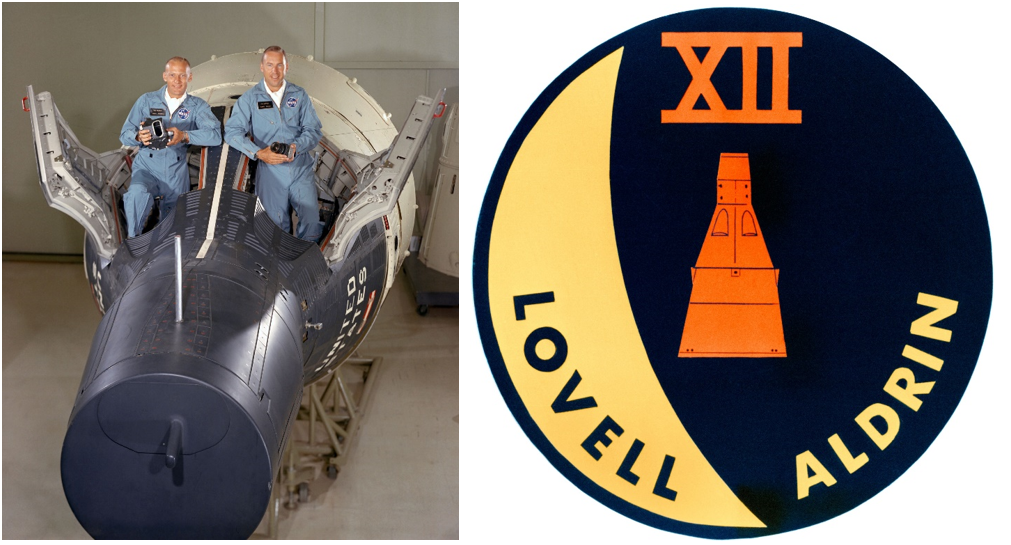
Left: The Gemini XII crew of Edwin E. “Buzz” Aldrin, left, and James A. Lovell. Right: The Gemini XII crew patch. Credits: NASA
In June 1966, NASA selected Gemini VII veteran Lovell and spaceflight rookie Aldrin as the prime crew for Gemini XII, with Mercury 9 and Gemini V veteran L. Gordon Cooper and Gemini IX veteran Eugene A. Cernan, as their backups.

Left: Gemini XII astronaut James A. Lovell prepares to climb aboard the Gemini Mission Simulator at the Manned Spacecraft Center in Houston, now NASA’s Johnson Space Center. Middle: Gemini XII astronaut Edwin E. “Buzz” Aldrin during his spacewalk training in a zero-g aircraft. Right: Aldrin, left, Lovell, and backup crew members L. Gordon Cooper and Eugene A. Cernan answer reporters’ questions during their pre-flight press conference. Credits: NASA
During an Oct. 31, 1966 press conference at the Manned Spacecraft Center (MSC) in Houston, now NASA’s Johnson Space Center, Lovell and Aldrin, along with their backups Cooper and Cernan, described their upcoming four-day mission to reporters. The first objective involved performing a rendezvous and docking with the Agena XII target vehicle, launching 90 minutes before Lovell and Aldrin. They would fire the Agena’s primary propulsion system (PPS) to raise the high point of their orbit to 460 miles.
On the second day, while still in this elliptical orbit, Aldrin would perform his first spacewalk, staying in the open Gemini hatch to install a temporary handrail to the Agena to aid in the second spacewalk and take photographs of stars in the ultraviolet spectrum, a spectrum of light that is 80% filtered out by Earth’s atmosphere. After the spacewalk, they would fire the Agena’s PPS to recircularize their orbit. On the third day, Aldrin would perform his second spacewalk, this one at the end of an umbilical allowing him to translate first to the Agena to attach a 100-foot tether to link the two spacecraft together, then to the rear of the Gemini’s adapter section. There, he would slip into foot restraints and, at a workstation, perform several tasks such as cutting a cable, connecting and disconnecting cables, and tightening bolts to evaluate the effectiveness of the restraint systems. He would then translate back to the Agena and conduct similar tests at a workstation there.
On the third day, Lovell and Aldrin would undock from the Agena and back away to the length of the 100-foot tether to attempt a gravity-gradient experiment. After releasing the tether and the Agena, Aldrin would conduct his third spacewalk, another standup activity to take more star photographs and jettison any unneeded equipment. They planned to return to Earth the following day with a splashdown in the western Atlantic Ocean, wrapping up the four-day mission and the Gemini program.

Using mock-ups of the Gemini and Agena spacecraft in the pool at the McDonogh School in Owings Mills, Maryland, astronaut Edwin E. “Buzz” Aldrin trains for his Gemini XII spacewalks in October 1966. Left: Aldrin practices installing a handrail between the Gemini and Agena spacecraft. Middle: Aldrin works at the Agena adapter. Right: Aldrin at the rear of the Gemini spacecraft’s instrument compartment, demonstrating the foot restraints. Credits: NASA
In preparation for lunar missions, astronauts needed to master working outside their spacecraft, and for the first few Gemini missions, training for spacewalks consisted of parabolic aircraft flights that provided brief 30-second episodes of weightlessness, overhead suspension, and air-bearing tables. However, astronauts during the Gemini IX, X, and XI missions experienced significant difficulties during their spacewalks, and NASA sought better methods of training. In 1966, the agency assessed the benefits of neutral buoyancy training, in which spacesuited astronauts practiced spacewalking tasks in swimming pools in an effort to simulate weightlessness. Astronaut M. Scott Carpenter provided a favorable assessment of training protocols established by Environmental Research Associates of Baltimore, Maryland, under contract to NASA’s Langley Research Center in Hampton, Virginia, using a swimming pool at the McDonogh School in Owings Mills, Maryland. On Sept. 12, 1966, with mock-ups of the Gemini and Agena target spacecraft placed in the McDonogh School’s pool, Aldrin became the first astronaut to use neutral buoyancy to train for his Gemini XII spacewalks. He returned in October for more training, less than one month before the actual mission.
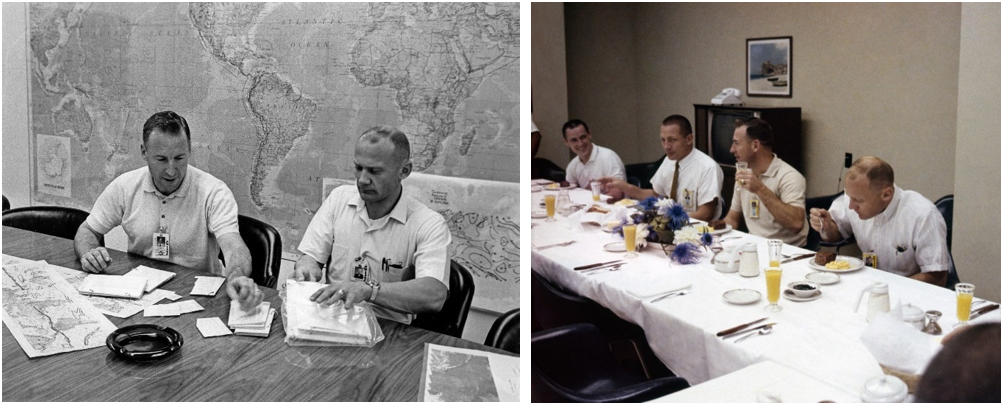
Left: Gemini XII astronauts James A. Lovell, left, and Edwin E. “Buzz” Aldrin review flight documents two days before launch. Right: Support astronauts Edward G. Gibson, left, and John L. “Jack” Swigert join Gemini XII astronauts Lovell and Aldrin for the traditional pre-launch breakfast. Credits: NASA
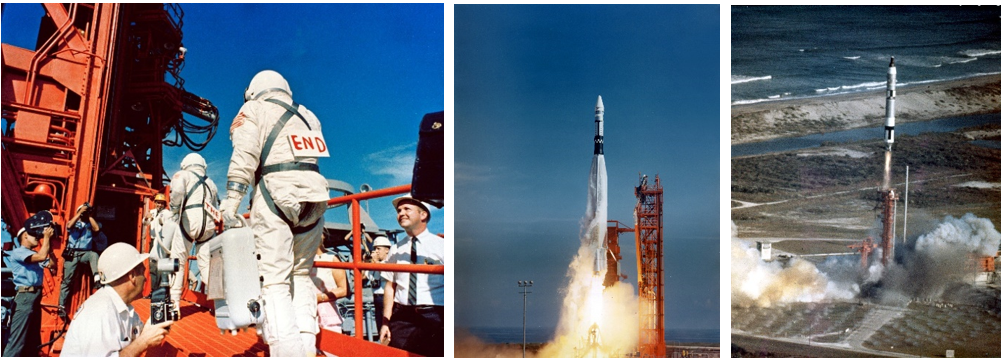
Left: Gemini XII astronauts James A. Lovell, left, and Edwin E. “Buzz” Aldrin, wearing signs marked “THE” and “END” to denote the final mission of the program, walk up the ramp to Launch Pad 19 at the Cape Kennedy Air Force Station in Florida, now the Cape Canaveral Space Force Station, to board their spacecraft. Middle: The launch of the Agena XII Target Vehicle. Right: The launch of Gemini XII as seen from a low-flying airplane. Credits: NASA
The launch of Gemini XII was scheduled for Nov. 9, but two separate 24-hour scrubs delayed the liftoff until Nov. 11. The Agena lifted off first, followed by Gemini XII about 90 minutes later. As Lovell and Aldrin approached the Agena target, their rendezvous radar proved erratic and had to be turned off. Using a backup rendezvous mode (onboard computations by Aldrin, who wrote his doctoral dissertation on the subject of orbital rendezvous), they successfully docked with the Agena on the third revolution. A problem with the Agena’s PPS prevented its firing to raise their orbit to the planned 460-mile altitude. Instead of the boost, Houston’s Mission Control Center instructed them that, with a slight orbital change, they would be able to observe and photograph a solar eclipse the next morning, as their trajectory would cross the path of totality. This required them to go to sleep one hour early and wake up two hours early the next day.
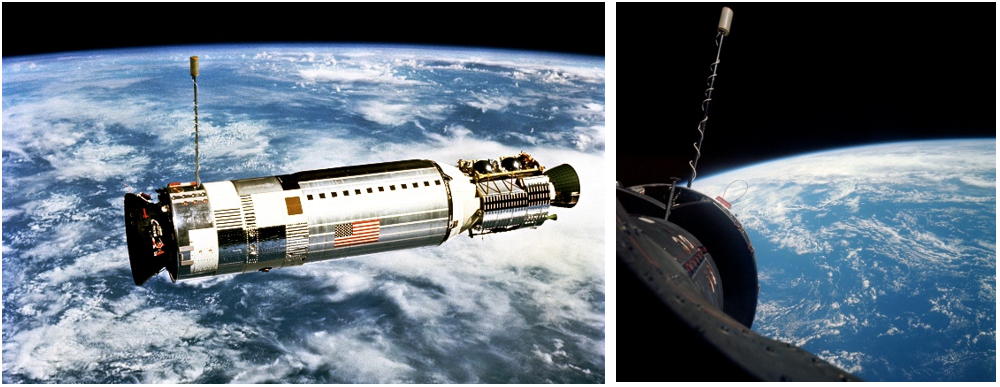
Left: The Agena XII target vehicle from a distance of 50 feet during the rendezvous maneuver. Right: Gemini XII docked with the Agena target vehicle. Credits: NASA
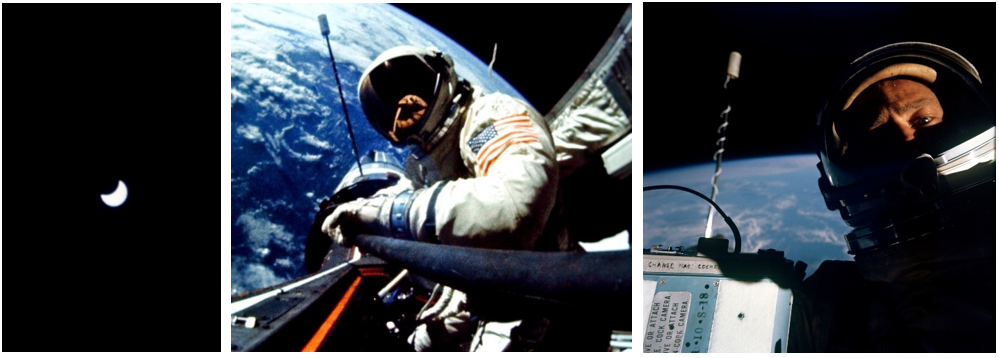
Left: Image of the solar eclipse taken from Gemini XII. Middle: During the first standup spacewalk, astronaut Edwin E. “Buzz” Aldrin installs a temporary handrail to the Agena while standing in the hatch of the Gemini XII spacecraft. Right: Aldrin pointed the camera at himself to take the first selfie during a spacewalk. Credits: NASA
At the start of their second day in space, during the few seconds their trajectory intersected the path of totality, Lovell and Aldrin took photographs of the solar eclipse for later study by scientists. Next, Aldrin began his first standup spacewalk, exclaiming “Man! Look at that!” as he opened the hatch and looked outside. As he worked, he reported that he had no difficulty maintaining his position in the open hatch, with only a very small tendency to float out. Aldrin installed a portable handrail to the Agena for the next day’s umbilical spacewalk. He devoted most of this first spacewalk to photography of hot stars, especially in the ultraviolet spectrum. Near the end of the spacewalk, Aldrin mounted the camera on the edge of the Gemini’s hatch, pointed it toward himself, and obtained the first selfies ever taken during a spacewalk, decades before the concept even existed. Aldrin closed the hatch after spending two hours and 28 minutes outside. After a well-earned meal, the crew went to sleep.
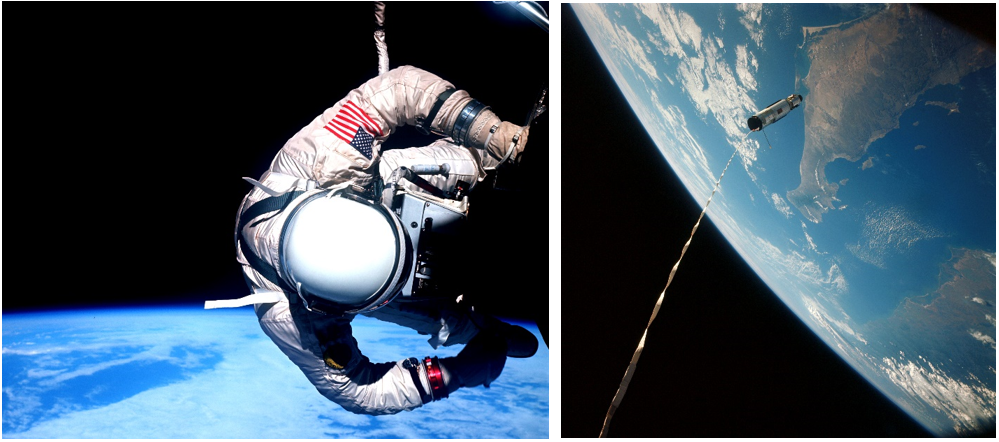
Left: Gemini XII astronaut Edwin E. “Buzz” Aldrin during the umbilical spacewalk. Right: The Agena XII target vehicle attached to Gemini XII by a 100-foot tether. Credits: NASA
Mission control awakened the crew about 90 minutes early to have them check a balky fuel cell. The astronauts elected not to go back to sleep once the problem was fixed, but to begin the day’s activities by performing some of the mission’s 14 scientific experiments. Attached to the Gemini by a 30-foot umbilical, Aldrin used the handrail he installed the previous day to translate to the Agena and attached a 100-foot tether to the target vehicle to be used during the next day’s experiment. After translating back to the hatch for a brief rest, Aldrin worked his way to the Gemini’s aft adapter section where, secured in foot restraints called “golden slippers,” he performed seven manual tasks to evaluate the effectiveness of the restraint, finding it adequate for the activities. He then returned to the Agena workstation to evaluate a waist tether restraint system while performing 12 additional tasks, reporting no issues with body positioning. After completing these activities and cleaning up the worksite, Aldrin returned to the Gemini and closed the hatch. The longest umbilical spacewalk to that time ended after two hours, nine minutes.
Lovell then undocked the Gemini from the Agena — the two spacecraft connected by the 100-foot tether. He slowly backed the Gemini away, trying to make the tether taut, eventually succeeding. With the heavier Agena orbiting below the lighter Gemini, Lovell turned off the control systems of both vehicles and they maintained their attitude in the gravity gradient mode without the use of thruster fuel. Lovell jettisoned the tether, ending the test after four hours, 20 minutes. They separated to a safe distance from the Agena before going to sleep.
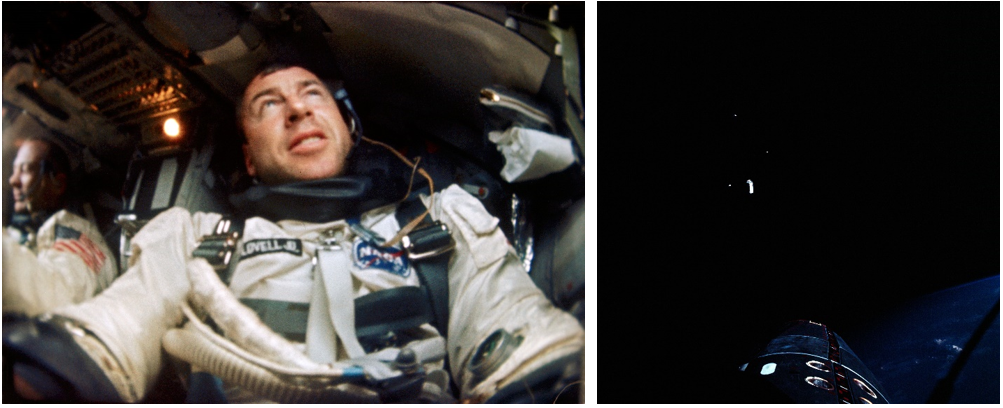
Left: In a still from a video, Gemini XII astronauts Edwin E. “Buzz” Aldrin, left, and James A. Lovell are seen in the cramped quarters of their spacecraft. Right: During the third spacewalk, Aldrin photographed several of the items he discarded, including the extravehicular life support system chest pack he used during the previous day’s umbilical spacewalk. Credits: NASA
The major activity for their final full day in space involved Aldrin’s third spacewalk, conducted in the Gemini hatch, to perform more ultraviolet photography and to jettison unused equipment. The spacewalk lasted one hour and 11 minutes, bringing Aldrin’s total spacewalk time to a then-record five hours, 48 minutes. It seemed like the problems encountered during previous Gemini spacewalks were overcome. Aldrin attributed his success to his neutral buoyancy training, a methodology still in use today, and to adequate restraint systems.
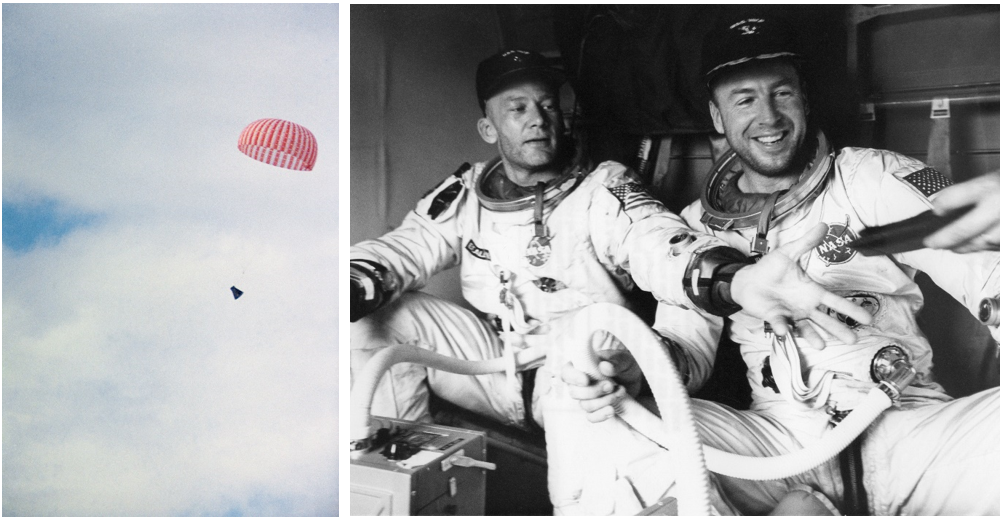
Left: The Gemini XII spacecraft descending on its parachute shortly before splashdown. Right: Gemini XII astronaut Edwin E. “Buzz” Aldrin, left, and James A. Lovell aboard the recovery helicopter. Credits: NASA
The following morning, Lovell and Aldrin prepared their spacecraft for the trip back to Earth. At the end of their 59th revolution, they fired Gemini XII’s retrorockets to bring them out of orbit. The spacecraft’s onboard computer guided them to a splashdown only three miles from the planned target and within sight of the prime recovery ship the USS Wasp (CVS-18). The last flight of the Gemini program lasted 94 hours and 34 minutes. Lovell and Aldrin elected to exit their spacecraft in the water and onto a life raft. Rescue crews hoisted them aboard a helicopter that flew them to the deck of the carrier about 30 minutes after splashdown for a celebratory welcome reception. Sailors later hoisted the Gemini XII spacecraft onto the ship. The next day, the astronauts flew by helicopter back to NASA’s Kennedy Space Center in Florida for several days of debriefings before returning to Houston’s Ellington Air Force Base near MSC for reunions with their families. After his two Gemini missions, Lovell was now the world’s most space-traveled man, having spent a total of 18 days in space.
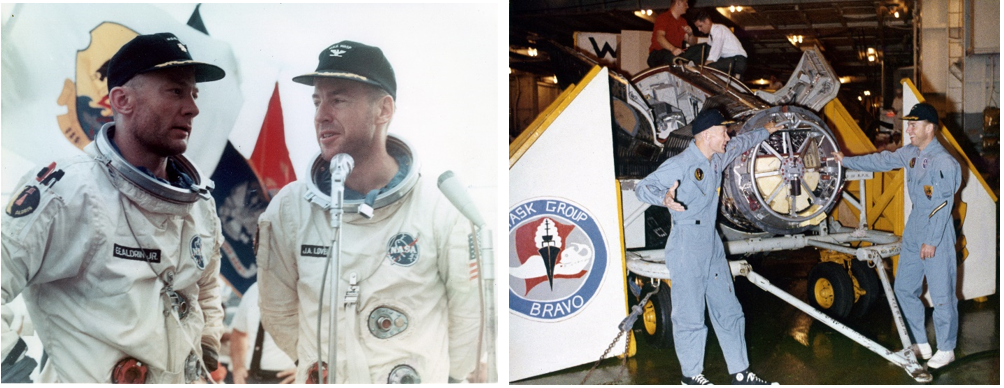
Left: Gemini XII astronauts Edwin E. “Buzz” Aldrin, left, and James A. Lovell on the deck of the prime recovery ship the USS Wasp. Right: Aldrin, left, and Lovell stand next to their Gemini XII spacecraft aboard the USS Wasp. Credits: NASA
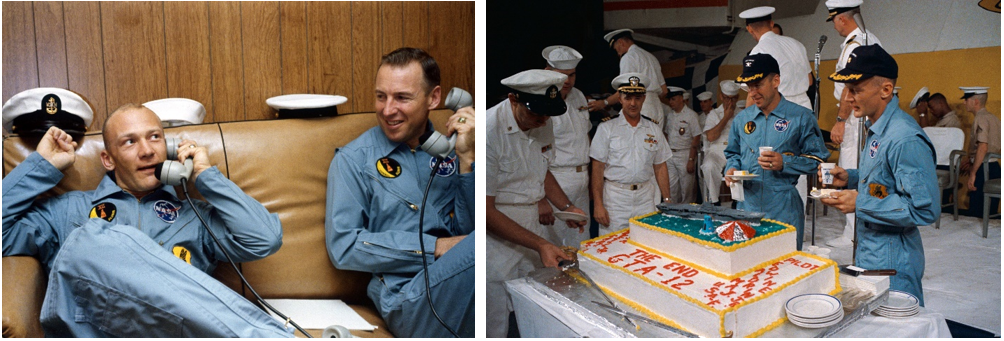
Left: Aboard the USS Wasp, Gemini XII astronauts Edwin E. “Buzz” Aldrin, left, and James A. Lovell receive congratulations from President Lyndon B. Johnson. Right: Lovell, left, and Aldrin enjoy celebratory cake aboard the Wasp. Credits: NASA
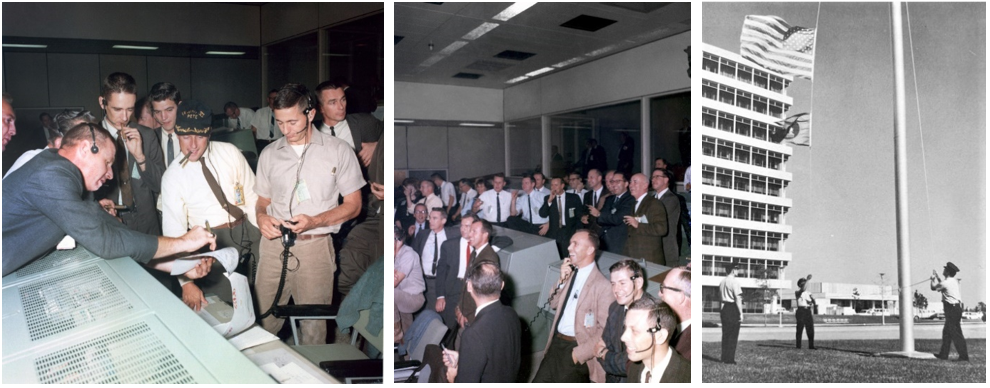
Left: In the Mission Control Center at the Manned Spacecraft Center, capsule communicators astronauts Charles “Pete” Conrad, center, and William A. Anders enjoy a light moment after the end of the Gemini XII mission. Middle: View of mission control following the safe splashdown of Gemini XII. Right: Outside MSC’s Project Management Building, security guards lower the U.S. flag and Gemini pennant for the last time following the Gemini XII splashdown. Credits: NASA
Outside MSC’s nine-story Project Management Building, security guards lowered the U.S. flag and Gemini program pennant for the last time following the Gemini XII splashdown. The flag and pennant were carried aboard the Gemini 3 mission in March 1965 by Virgil I. “Gus” Grissom and John W. Young and flew on the MSC flagstaff around the clock during every subsequent Gemini mission. The flag and pennant were retired and displayed in the MSC auditorium lobby.
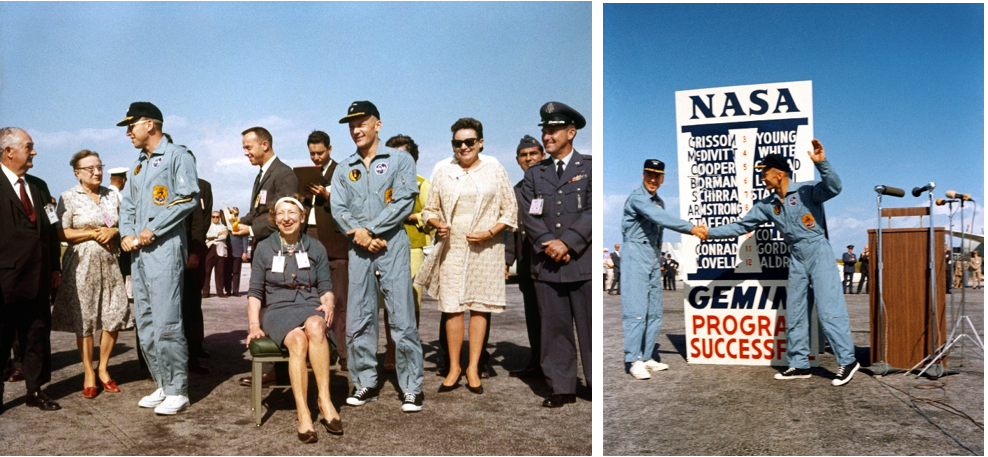
Left: Gemini XII astronauts James A. Lovell, left, and Edwin E. “Buzz” Aldrin greeted by colleagues and family following their return to NASA’s Kennedy Space Center in Florida. Right: Lovell, left, and Aldrin shake hands in front of a sign commemorating the successful conclusion of the Gemini program. Credits: NASA
The splashdown of Gemini XII ended the highly successful Gemini program. Ten crewed missions were flown in 20 months and, although some encountered technical issues, all the major program objectives were accomplished, paving the way for the Apollo program and the first Moon landing less than three years later. On Nov. 23, Lovell and Aldrin summarized their mission, including narrating a film of their flight, to assembled reporters during a two-hour press conference in MSC’s main auditorium.
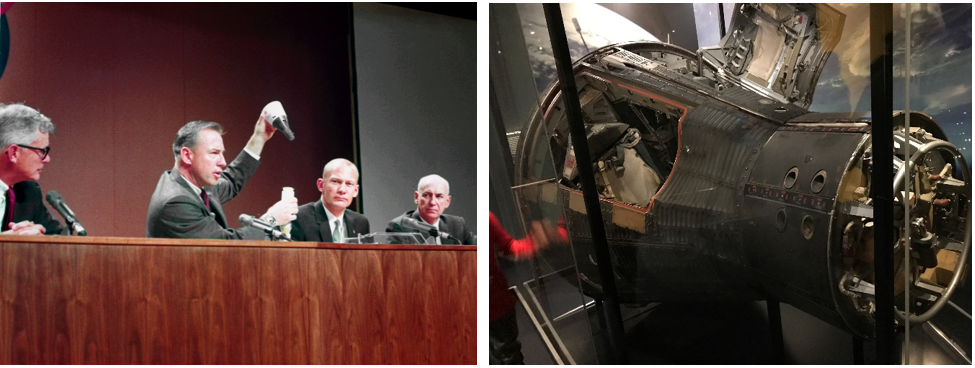
Left: Robert C. Seamans, NASA deputy administrator, left, and Robert R. Gilruth, director of the Manned Spacecraft Center, right, flank Gemini XII astronauts James A. Lovell, left, and Edwin E. “Buzz” Aldrin during the postflight press conference in the MSC auditorium as Lovell demonstrates the tethered experiment. Right: The Gemini XII spacecraft on display at the Adler Planetarium in Chicago. Credits: NASA
The Gemini XII spacecraft is on display at the Adler Planetarium in Chicago.
Enjoy a video (below) of the Gemini XII mission.







